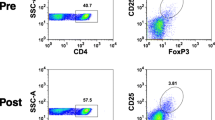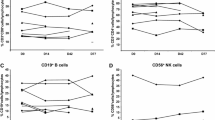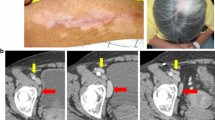Abstract
Purpose: To assess changes in serum cytokine levels in patients treated concomitantly with or without systemic low-dose IL-2. Vaccination targeted CTL responses to peptide antigens, and IL-2 was coadministered to expand activated CTL. Paradoxically, CTL responses were diminished in patients after 2 weeks of IL-2. We hypothesized that changes in the cytokine milieu may have contributed to this result. Experimental design: Serum samples were studied from 37 patients enrolled in two clinical trials of a melanoma peptide vaccine administered with or without low-dose IL-2 therapy. Twenty-two patients enrolled in the MEL36 trial received six weekly vaccinations with the four-peptide mixture and were randomized to receive subcutaneous IL-2 (3×106 IU/m2/day) daily for 6 weeks beginning either at week 1 (upfront group) or at week 4 (delayed group) of vaccine therapy. Fifteen patients on the MEL39 trial were treated with the same vaccine without concurrent IL-2 administration. Results: Circulating levels of IL-5 peaked 1 week after starting IL-2, followed 2 weeks later by a marked eosinophilia, correlating in magnitude with peak IL-5 serum levels. Levels of IFNγ, GM-CSF, IL-4, IL-10, and IL-12 had no observed relationship to IL-2 administration. At the time of the IL-5 serum peak, PBL responses to mitogen suggested a transient shift to Th2-dominance. Conclusions: Low-dose IL-2 appears to have induced a transient Th2-dominant secondary cytokine cascade at the time of vaccination, for which eosinophilia is a surrogate marker. For future vaccine therapies targeting cytotoxic T-cell responses, delaying IL-2 until after initiation of immune responses may be more effective.





Similar content being viewed by others
References
Darrow TL, Slingluff CL, Seigler HF (1988) Autologous lymph node cell-derived tumor-specific cytotoxic T-cells for use in adoptive immunotherapy of human melanoma. Cancer 62:84–91
Slingluff CL Jr, Darrow TL, Seigler HF (1989) Melanoma-specific cytotoxic T cells generated from peripheral blood lymphocytes. Implications of a renewable source of precursors for adoptive cellular immunotherapy. Ann Surg 210:194–202
Yamshchikov G, Thompson L, Ross WG, Galavotti H, Aquila W, Deacon D, Caldwell J, Patterson JW, Hunt DF, Slingluff CL Jr (2001) Analysis of a natural immune response against tumor antigens in a melanoma survivor: lessons applicable to clinical trial evaluations. Clin Cancer Res 7:909s–916s
Rosenberg SA, Yang JC, Schwartzentruber DJ, Hwu P, Marincola FM, Topalian SL, Restifo NP, Sznol M, Schwarz SL, Spiess PJ, Wunderlich JR, Seipp CA, Einhorn JH, Rogers-Freezer L, White DE (1999) Impact of cytokine administration on the generation of antitumor reactivity in patients with metastatic melanoma receiving a peptide vaccine. J Immunol 163:1690–1695
Slingluff CL Jr, Yamshchikov GY, Barnd DL, Eastham S, Galavotti H, Patterson JW, Deacon DH, Hibbitts S, Teates D, Neese PY, Grosh WW, Petroni GR, Gibson J, Czarkowski AR, Ross M, Engelhard VH, Ross WG (2003) Clinical and immunologic results of a randomized phase II trial of vaccination utilizing four melanoma peptides either administered in GMCSF-in-adjuvant or pulsed on dendritic cells. J Clin Oncol 21:4016–4026
Thurner B, Haendle I, Roder C, Dieckmann D, Keikavoussi P, Jonuleit H, Bender A, Maczek C, Schreiner D, von den Driesch P, Brocker EB, Steinman RM, Enk A, Kampgen E, Schuler G (1999) Vaccination with mage-3A1 peptide-pulsed mature, monocyte-derived dendritic cells expands specific cytotoxic T cells and induces regression of some metastases in advanced stage IV melanoma. J Exp Med 190:1669–1678
Tatsumi T, Kierstead LS, Ranieri E, Gesualdo L, Schena FP, Finke JH, Bukowski RM, Mueller-Berghaus J, Kirkwood JM, Kwok WW, Storkus WJ (2002) Disease-associated bias in T helper type 1 (Th1)/Th2 CD4(+) T cell responses against MAGE-6 in HLA-DRB10401(+) patients with renal cell carcinoma or melanoma. J Exp Med 196:619–628
Lowes MA, Bishop GA, Crotty K, Barnetson RS, Halliday GMT (1997) Helper 1 cytokine mRNA is increased in spontaneously regressing primary melanomas. J Invest Dermatol 108:914–919
Thompson RC, Pardoll DM, Jaffee EM, Ewend MG, Thomas MC, Tyler BM, Brem H (1996) Systemic and local paracrine cytokine therapies using transduced tumor cells are synergistic in treating intracranial tumors. J Immunother Emphasis Tumor Immunol 19:405–413
Nigam A, Yacavone RF, Zahurak ML, Johns CM, Pardoll DM, Piantadosi S, Levitsky HI, Nelson WG (1998) Immunomodulatory properties of antineoplastic drugs administered in conjunction with GM-CSF-secreting cancer cell vaccines. Int J Oncol 12:161–170
Ahlers JD, Dunlop N, Alling DW, Nara PL, Berzofsky JA (1997) Cytokine-in-adjuvant steering of the immune response phenotype to HIV-1 vaccine constructs: granulocyte-macrophage colony-stimulating factor and TNF-alpha synergize with IL-12 to enhance induction of cytotoxic T lymphocytes. J Immunol 158:3947–3958
Atkins MB, Kunkel L, Sznol M, Rosenberg SA (2000) High-dose recombinant interleukin-2 therapy in patients with metastatic melanoma: long-term survival update. Cancer J Sci Am 6(Suppl 1):11–14
Guirguis LM, Yang JC, White DE, Steinberg SM, Liewehr DJ, Rosenberg SA, Schwartzentruber DJ (2002) Safety and efficacy of high-dose interleukin-2 therapy in patients with brain metastases. J Immunother 25:82–87
Janssen RA, Mulder NH, The TH, de Leij L (1994) The immunobiological effects of interleukin-2 in vivo. Cancer Immunol Immunother 39:207–216
Palmieri G, Montella L, Milo M, Fiore R, Biondi E, Bianco AR, Martignetti A (2002) Ultra-low-dose interleukin-2 in unresectable hepatocellular carcinoma. Am J Clin Oncol 25:224–226
Rosenberg SA, Yang JC, Topalian SL, Schwartzentruber DJ, Weber JS, Parkinson DR, Seipp CA, Einhorn JH, White DE (1994) Treatment of 283 consecutive patients with metastatic melanoma or renal cell cancer using high-dose bolus interleukin 2. JAMA 271:907–913
Hefeneider SH, Conlon PJ, Henney CS, Gillis S (1983) In vivo interleukin 2 administration augments the generation of alloreactive cytolytic T lymphocytes and resident natural killer cells. J Immunol 130:222–227
Soiffer RJ, Murray C, Cochran K, Cameron C, Wang E, Schow PW, Daley JF, Ritz J (1992) Clinical and immunologic effects of prolonged infusion of low-dose recombinant interleukin-2 after autologous and T-cell-depleted allogeneic bone marrow transplantation. Blood 79:517–526
Soiffer RJ, Murray C, Shapiro C, Collins H, Chartier S, Lazo S, Ritz J (1996) Expansion and manipulation of natural killer cells in patients with metastatic cancer by low-dose continuous infusion and intermittent bolus administration of interleukin 2. Clin Cancer Res 2:493–499
Engelhardt M, Wirth K, Mertelsmann R, Lindemann A, Brennscheidt U (1997) Clinical and immunomodulatory effects of repetitive 2-day cycles of high-dose continuous infusion IL-2. Eur J Cancer 33:1050–1054
Schaafsma MR, Falkenburg JH, Landegent JE, Duinkerken N, Osanto S, Ralph P, Kaushansky K, Wagemaker G, Van Damme J, Willemze R et al (1991) In vivo production of interleukin-5, granulocyte-macrophage colony-stimulating factor, macrophages colony-stimulating factor, and interleukin-6 during intravenous administration of high-dose interleukin-2 in cancer patients. Blood 78:1981–1987
Phan GQ, Attia P, Steinberg SM, White DE, Rosenberg SA (2001) Factors associated with response to high-dose interleukin-2 in patients with metastatic melanoma. J Clin Oncol 19:3477–3482
Takeuchi E, Yanagawa H, Suzuki Y, Shinkawa K, Bando H, Sone S (2001) Interleukin (IL-)15 has less activity than IL-2 to promote type 2 cytokine predominance in tumour-associated mononuclear cells from lung cancer patients. Cytokine 13:119–123
Slingluff CL Jr, Petroni GR, Yamshchikov GV, Hibbitts S, Grosh WW, Chianese-Bullock KA, Bissonette EA, Barnd DL, Deacon DH, Patterson JW, Parekh J, Neese PY, Woodson EM, Wiernasz CJ, Merrill P (2004) Immunologic and clinical outcomes of vaccination with a multiepitope melanoma peptide vaccine plus low-dose interleukin-2 administered either concurrently or on a delayed schedule. J Clin Oncol 22:4474–4485
Woodson EM, Chianese-Bullock KA, Wiernasz K, Bissonette EA, Grosh WW, Neese P, Merrill P, Barnd DL, Petroni G, Slingluff CL Jr (2004) Assessment of the toxicities of systemic low-dose IL-2 administered in conjunction with a melanoma peptide vaccine. J Immunother 27:380–388
Sosman JA, Bartemes K, Offord KP, Kita H, Fisher SG, Kefer C, Ellis TA, Fisher RI, Higgins TJ, Gleich GJ (1995) Evidence for eosinophil activation in cancer patients receiving recombinant interleukin-4: effects of interleukin-4 alone and following interleukin-2 administration. Clin Cancer Res 1:805–812
van Haelst Pisani C, Kovach JS, Kita H, Leiferman KM, Gleich GJ, Silver JE, Dennin R, Abrams JS (1991) Administration of interleukin-2 (IL-2) results in increased plasma concentrations of IL-5 and eosinophilia in patients with cancer. Blood 78:1538–1544
Skipper JC, Hendrickson RC, Gulden PH, Brichard V, Van Pel A, Chen Y, Shabanowitz J, Wolfel T, Slingluff CL Jr, Boon T, Hunt DF, Engelhard VH (1996) An HLA-A2-restricted tyrosinase antigen on melanoma cells results from posttranslational modification and suggests a novel pathway for processing of membrane proteins. J Exp Med 183:527–534
Chen Y, Sidney J, Southwood S, Cox AL, Sakaguchi K, Henderson RA, Appella E, Hunt DF, Sette A, Engelhard VH (1994) Naturally processed peptides longer than nine amino acid residues bind to the class I MHC molecule HLA-A2.1 with high affinity and in different conformations. J Immunol 152:2874–2881
Kittlesen DJ, Thompson LW, Gulden PH, Skipper JC, Colella TA, Shabanowitz J, Hunt DF, Engelhard VH, Slingluff CL Jr, Shabanowitz JA (1998) Human melanoma patients recognize an HLA-A1-restricted CTL epitope from tyrosinase containing two cysteine residues: implications for tumor vaccine development. J Immunol 160:2099–2106
Skipper JC, Kittlesen DJ, Hendrickson RC, Deacon DD, Harthun NL, Wagner SN, Hunt DF, Engelhard VH, Slingluff CL Jr (1996) Shared epitopes for HLA-A3-restricted melanoma-reactive human CTL include a naturally processed epitope from Pmel-17/gp100. J Immunol 157:5027–5033
Slingluff CL Jr, Yamshchikov G, Neese P, Galavotti H, Eastham S, Engelhard VH, Kittlesen D, Deacon D, Hibbitts S, Grosh WW, Petroni G, Cohen R, Wiernasz C, Patterson JW, Conway BP, Ross WG (2001) Phase I trial of a melanoma vaccine with gp100(280–288) peptide and tetanus helper peptide in adjuvant: immunologic and clinical outcomes. Clin Cancer Res 7:3012–3024
Slingluff CL Jr, Cox AL, Henderson RA, Hunt DF, Engelhard VH (1993) Recognition of human melanoma cells by HLA-A2.1-restricted cytotoxic T lymphocytes is mediated by at least six shared peptide epitopes. J Immunol 150:2955–2963
Kenyon NJ, Kelly EA, Jarjour NN (2000) Enhanced cytokine generation by peripheral blood mononuclear cells in allergic and asthma subjects. Ann Allergy Asthma Immunol 85:115–120
Shrikant P, Mescher MF (2002) Opposing effects of IL-2 in tumor immunotherapy: promoting CD8 T cell growth and inducing apoptosis. J Immunol 169:1753–1759
Macdonald D, Gordon AA, Kajitani H, Enokihara H, Barrett AJ (1990) Interleukin-2 treatment-associated eosinophilia is mediated by interleukin-5 production. Br J Haematol 76:168–173
Sun Q, Jones K, McClure B, Cambareri B, Zacharakis B, Iversen PO, Stomski F, Woodcock JM, Bagley CJ, D’Andrea R, Lopez AF (1999) Simultaneous antagonism of interleukin-5, granulocyte-macrophage colony-stimulating factor, and interleukin-3 stimulation of human eosinophils by targetting the common cytokine binding site of their receptors. Blood 94:1943–1951
Lopez AF, Sanderson CJ, Gamble JR, Campbell HD, Young IG, Vadas MA (1988) Recombinant human interleukin 5 is a selective activator of human eosinophil function. J Exp Med 167:219–224
Warren HS, Kinnear BF, Phillips JH, Lanier LL (1995) Production of IL-5 by human NK cells and regulation of IL-5 secretion by IL-4, IL-10, and IL-12. J Immunol 154:5144–5152
Yamaguchi Y, Suda T, Shiozaki H, Miura Y, Hitoshi Y, Tominaga A, Takatsu K, Kasahara T (1990) Role of IL-5 in IL-2-induced eosinophilia. In vivo and in vitro expression of IL-5 mRNA by IL-2. J Immunol 145:873–877
Sasaki G, Satoh T, Yokozeki H, Katayama I, Nishioka K (2000) Regulation of cyclophosphamide-induced eosinophilia in contact sensitivity: functional roles of interleukin-5-producing CD4(+) lymphocytes. Cell Immunol 203:124–133
Acknowledgements
We thank Melanie Mayer for her assistance with the manuscript preparation and submission. This research was supported in part by NIH/NCI grant R01 CA57653 (to CLS), by Chiron Corporation, by an American Cancer Society Virginia Summer Student Fellowship Grant (to WCC), the University of Virginia Cancer Center Support Grant (NIH/NCI P30 CA44579, Clinical Trials Office, Tissue Procurement Facility, Biomolecular Core Facility); the UVA General Clinical Research Center (NIH M01 RR00847); and the Pratt Fund at the University of Virginia. Cancer Research Institute supported infrastructure of the UVA Human Immune Therapy Center.
Author information
Authors and Affiliations
Corresponding author
Additional information
William Chad Cragun and Galina V. Yamshchikov contributed equally to this paper.
Rights and permissions
About this article
Cite this article
Cragun, W.C., Yamshchikov, G.V., Bissonette, E.A. et al. Low-dose IL-2 induces cytokine cascade, eosinophilia, and a transient Th2 shift in melanoma patients. Cancer Immunol Immunother 54, 1095–1105 (2005). https://doi.org/10.1007/s00262-005-0701-6
Received:
Accepted:
Published:
Issue Date:
DOI: https://doi.org/10.1007/s00262-005-0701-6




